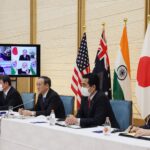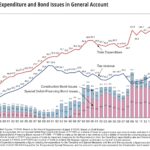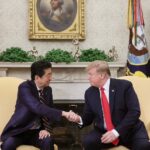Kojima Akira comments on the battle for supremacy as automakers around the world accelerate their development of EVs.
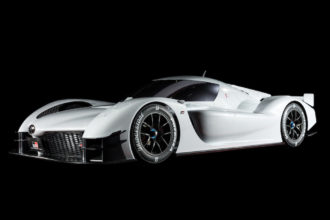
Toyota Gazoo Racing unveiled the road-going GR Super Sport Concept at Tokyo Auto Salon 2018 in January. The car incorporates hybrid technology honed through participation in the FIA World Endurance Championship (WEC).
TOYOTA GLOBAL NEWSROOM PHOTO
The full-scale practical application of electric vehicles (EVs) that only two or three years ago was expected to happen sometime in the far future has already become a reality, and now that China, the world’s largest automobile market, has become a major battleground for market share, makers of automobiles from around the world are facing intense competition. An historic drama, one that might be titled “Story of the EV Wars,” is unfolding, featuring among other things, automakers entering into unusual cross-border corporate partnerships, dramatic company takeovers, contests to secure the best people and new corporations entering the market.
The automobile industry is Japan’s largest and most pivotal industry, and also serves as a vanguard for the rest of Japan’s existing industries. The household electrical and electronic devices industries also led the development of Japan’s industry for a while. However, having recently been forced to confront the reality that South Korea and some emerging countries are hard on its heels, the trade balance of the entire electronics industry is now showing a deficit. The truth is that only in the automobile industry is Japan winning against the global competition and playing a leading role in the automobile industry around the world. The Japanese automobile industry overtaking that of the United States (known as the Empire of the Car), exemplified by Toyota, which accelerated the development of new global markets with hybrid vehicles, was a major success story for the Japanese industry.
The possibility, however, that the emergence of EVs, essentially automobiles without engines, could significantly alter the configuration of the world’s automobile industry has arisen.
The rapid development of technologies for EVs, changes in values toward environmental issues, and the positioning of EVs as a growth field in the twenty-first century, as exemplified by China, heavily embracing EVs as one of its strategic industrial policies could be cited as the backdrop to this. None of the above factors are fleeting. The world automobile industry paradigm is about to be turned on its head in a historic way.

Daihatsu, a subsidiary of Toyota Motor, debuted its new petrol-electric hybrid concept car the DN Compagno at the 2017 Tokyo Motor Show. The design is inspired by the company’s 1960s model of the same name. As competition heats up, automakers are becoming increasingly creative in their electric car designs.
THE JAPAN JOURNAL
The focus is now on the Chinese market, the strategies adopted by the Chinese government and the moves made by Chinese companies. Environmental issues such as air pollution, which has entered a critical stage in large cities, has become a serious political issue in China. The Chinese government has responded by keeping out engine-based vehicles and making the decision to move to EVs or new energy vehicles (NEVs). As a definite manifestation of the Chinese government’s intentions, it has made it compulsory that, from 2019, 10% or more of automobiles produced and sold in China are NEVs. In 2020, this percentage will rise to 12% and an eventual complete ban on production and sale of gasoline and diesel vehicles is being discussed.
Battlefield China
The rationale for such a policy is “protection of the environment,” but the Chinese government also has another aim, namely, to position its automobile industry as one of the Chinese state’s most prestigious enterprises to make the “Chinese dream” possible. This is an ambitious industrial policy on the part of the Chinese government. By embracing EVs, the Chinese government tries to, at one stroke, make up for its underwhelming record with gasoline vehicles. China was never going to win against Japan, Europe or the United States when it came to gasoline vehicles. With EVs though, China can compete side by side with all those countries. China, having realized this, appears to have adopted a “leap-frog” strategy to place itself in the foreground for EVs. With the realization that China’s strategy is “for real,” automakers from other countries have suddenly accelerated their development of EVs.
The reasons for China being the battlefield for the EV wars are that it is already the world’s largest automobile market and that its automobile market is expected to expand rapidly for some time.
In 2017, the number of sales of new cars in China increased by 3% on the previous year at 28,878,900 units (announced by the China Automobile Manufacturers Association), exceeding that of the United States by 180,000.
World automakers will be drawn to this “world’s largest market.” They will compete to take advantage of the Chinese government’s policy. Japanese automakers that have maintained a dominant position leveraging hybrid vehicles and high quality have also initiated a “China shift.” In February 2018, Nissan’s Chinese joint venture announced that it would be investing 60 billion yuan (around 1 trillion yen) over the next five years in the development of EVs and other types of vehicles. The announcement that Germany’s Volkswagen (VW) would be investing 10 billion euros in EV conversion by 2015 attracted world attention, but the joint venture’s investment is equivalent to that. Also notable is the fact that VW has established its third joint venture company in China, and will begin manufacturing EVs from 2018. The US automaker General Motors (GM) has also sold more than four million units in China, and intends to introduce a number of EV vehicles to China, including the Cadillac, which is GM’s luxury model.
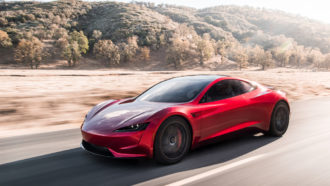
US venture company Tesla has inspired hundreds of companies to replicate its success in the Chinese EV market. Pictured, the Tesla Roadster.
COURTESY TESLA
Automakers in China have also undergone great change. Germany’s Daimler AG’s largest shareholder is a Chinese company. Chinese manufacturers have established bases in Silicon Valley in the United States to develop technologies for EVs and automated driving, and are actively recruiting talented human resources for development from the United States and also from Japan. Executives of Xiaopeng Motors in Guangdong Province in which Alibaba is making a significant investment, have gathered together human resources for development from other countries and have declared that the company will increase the number of automated driving engineers six-fold to 600 within the year.
Last year the news broke that the market capitalization of the US venture company Tesla, which has embarked on the production of EVs, had surpassed that of GM. Dreaming of a Chinese version of Tesla, several hundreds of companies have entered the Chinese market. Many of them have failed, but dozens are still surviving, challenging themselves to a new era in the automobile industry. The pace of change is definitely picking up speed.
KOJIMA Akira is a member of the Board of Trustees and professor of the National Graduate Institute for Policy Studies.

